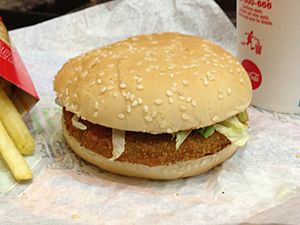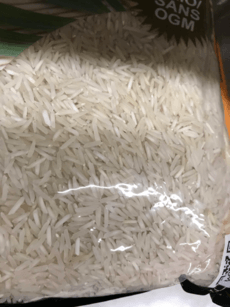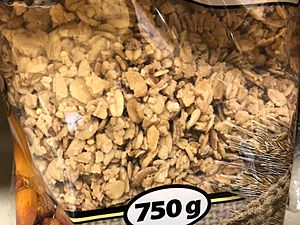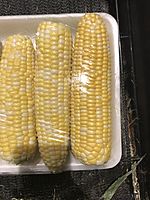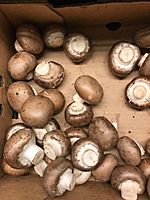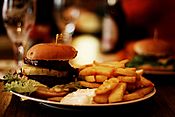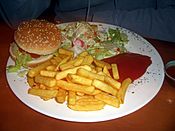Veggie burger facts for kids
| Type | Sandwich |
|---|---|
| Main ingredients | Vegetables, textured vegetable protein, legumes, nuts, mushrooms, or grains or seeds |
A veggie burger is a burger patty that does not have meat. These burgers are made from plant-based ingredients. They can include beans, like soybeans and tofu, nuts, grains, seeds, or fungi like mushrooms.
People in different parts of Eurasia have made patties like veggie burgers for thousands of years. These patties could be grilled or fried, similar to meatballs or koftas found in Indian cuisine. They might have meat or be made only from plants, such as beans or other plant proteins.
Contents
Who Invented the Veggie Burger?
Many people claim to have invented the veggie burger. The name "VegeBurger" might have been first used in London in 1982 by Gregory Sams. He and his brother had a natural food restaurant. When his "VegeBurger" was first sold, it was very popular.
However, an older mention of "vegeburgers" appeared in a 1948 American radio show. In this show, a character talked about a burger made from nuts and beans.
Around 1980 or 1981, Paul Wenner created an early veggie burger called the Gardenburger. He made it at his vegetarian restaurant in Gresham, Oregon.
Where to Find Veggie Burgers
Since the early 2000s, many fast food places have started offering vegetarian options.
Veggie Burgers in India
In India, where many people are vegetarian, you can find veggie burgers at McDonald's, Burger King, Wendy's, and KFC. In 2012, McDonald's even opened its first restaurant in India that only serves vegetarian food.
Veggie Burgers in the United States
By 2005, veggie burgers were available at Burger King and Hungry Jack's in the United States. You could also find them at some Subways and Harvey's. Many other restaurants, like Red Robin, Chili's, and Denny's, also offer them. Sometimes, the veggie burger is listed as an option to swap for a beef or turkey burger.
McDonald's Veggie Burgers
McDonald's offers different kinds of veggie burgers in many countries. These include the vegetarian McVeggie and the vegan McVegan.
You can find them in:
- India: The McVeggie has a fried patty made of vegetables, with lettuce and ketchup.
- Bahrain
- Cheung Chau, Hong Kong: The McVeggie is sold during the Cheung Chau Bun Festival.
- Egypt: The McFalafel has a falafel patty with tomato, lettuce, and tahini sauce.
- Finland: The McVegan is available here.
- Germany: McDonald's Germany started serving veggie burgers in all its restaurants in 2010.
- Greece: The McVeggie has a breaded and fried vegetable patty with tomato, lettuce, and ketchup.
- Malaysia
- The Netherlands: They have a "Groentenburger," which means "Vegetable Burger."
- Portugal: The McVeggie has been available since 2016.
- New Zealand: The McVeggie arrived in 2019.
- Sweden: The McVegan is served here.
- Switzerland: They have the "Vegi Mac."
- United Arab Emirates
- United Kingdom: McDonald's in the UK offers a "Vegetable Deluxe," which is a mixed vegetable patty.
How Veggie Burgers Are Made
Making veggie burgers often involves several steps. Here's how it generally works:
First, the grains and vegetables are washed very well. This removes any dirt, bacteria, or other unwanted things. This can be done by hand or with machines that spray water at high pressure.
Next, a special mixer that uses steam cooks the grains. It also removes extra water. This mixer often has oils like safflower oil. As the oil heats up, grains are added and mixed. The steam helps the grains cook and turn into a soft mixture.
Then, vegetables are cut into smaller pieces. This helps them cook more evenly. This can be done by hand or by machines in factories.
The cut vegetables are added to the grain mixture in the steam-heated mixer. Each company uses a different amount of grains and vegetables. This creates different textures and tastes for their burgers.
As the vegetables cook, their natural sugars come out and caramelize. This creates sweet flavors that mix throughout. This cooking method is called mirepoix. It's important because it adds both texture and flavor to the patty.
The cooked mixture is then moved to another mixer. Here, dry ingredients like oats, walnuts, and potato flakes are added. The mixture is folded together until it's uniform. The moisture from the vegetables makes the mix sticky, like cookie dough. This stickiness helps the veggie burger hold its shape.
Now, the mixture goes into a machine that makes patties automatically. This machine presses the mix into disc shapes onto a conveyor belt. Water might be sprayed to stop the mix from sticking to the machine. The patties then move to baking trays.
The patties are checked to make sure they have the right shape, size, and texture. Then, the trays are put into a hot convection oven to bake.
After baking, the patties are quickly frozen. Methods like individual quick freezing are used. These methods freeze the patties in about 30 minutes. This helps keep the nutrients and texture by forming many small ice crystals.
The frozen patties are then put on a conveyor belt again. They go to a vacuum-packaging machine. This machine seals the patties in plastic sleeves and removes extra air. Finally, the packages are put into cardboard boxes. These boxes are sealed and stored in a cool place until they are sent to stores.
Why Ingredients Are Used
Grains in Veggie Burgers
Grains like rice and wheat are a main part of veggie burgers. They act as a meat substitute. Grains provide carbohydrates and protein. They also give the patty its bulk and texture. The type of grain used can change how the burger feels when you eat it. This texture and look are important to make the patty seem like a beef burger.
Vegetables in Veggie Burgers
Vegetables such as corn, carrots, and mushrooms give the patty its texture and taste. When heated, they also release moisture. This helps the patty stay together in its disc shape. Vegetables also add nutrients, including vitamins and minerals.
Dry Ingredients in Veggie Burgers
Adding dry ingredients like oats, flours, nuts, or breadcrumbs helps soak up extra moisture. This makes the patty stick together tightly. It turns the moist veggie mix into a sticky dough, which helps shape the patties easily. Dry ingredients also add proteins and fiber, making the burger more nutritious. Nuts like walnuts and almonds are also full of energy, vitamins, and minerals.
Stabilizers in Veggie Burgers
Tapioca starch and vegetable gum are often used as stabilizers in veggie burgers. Tapioca starch is a common thickening agent because it's cheap. It gets sticky when wet, which helps hold the burger patty together. This stops the patty from breaking apart. Vegetable gum also helps keep all the ingredients in the patty connected.
Oils in Veggie Burgers
Oils, such as safflower, coconut, and olive oil, help mix the grains and allow them to cook further. They help create a process called the Maillard reaction, which makes the veggie patty taste better by bringing out flavors. Oils also stop ingredients from sticking to the mixing machine, so everything mixes well.
Preservatives in Veggie Burgers
Salt is used for flavor, but it can also act as a preservative in veggie burgers. Salt reduces the amount of "free" water in the food. This helps stop tiny organisms from growing and makes the food last longer.
What Are Veggie Burgers Called?
In October 2020, the European Union decided not to pass a rule that would have forced companies to call veggie burgers "veggie discs." So, they can still be called veggie burgers!
Gallery
-
A Burger King Veggie combo meal, including a veggie burger, from Germany
-
Vegan burger and French fries
-
Order from a vegetarian deli: veggie burger with French fries and salad
See also
 In Spanish: Hamburguesa vegetal para niños
In Spanish: Hamburguesa vegetal para niños


